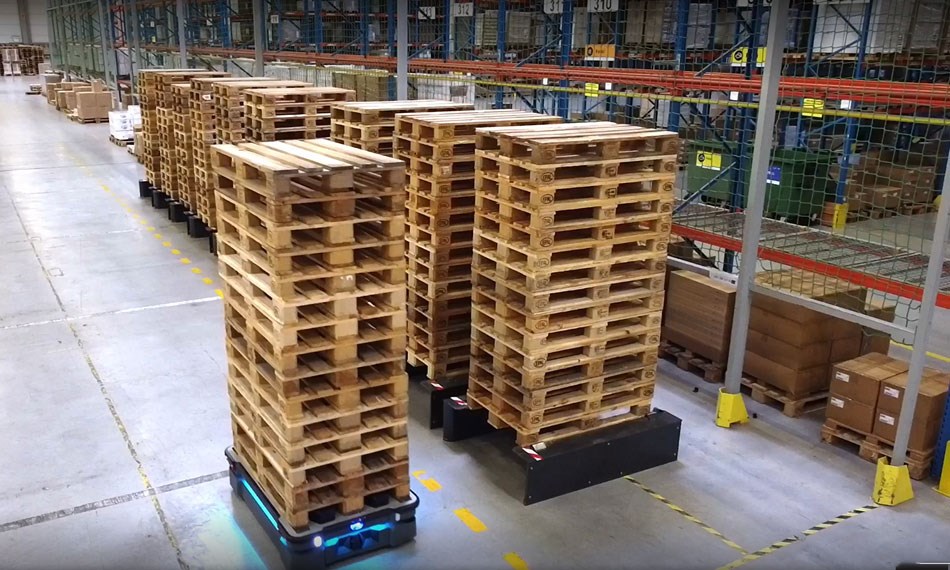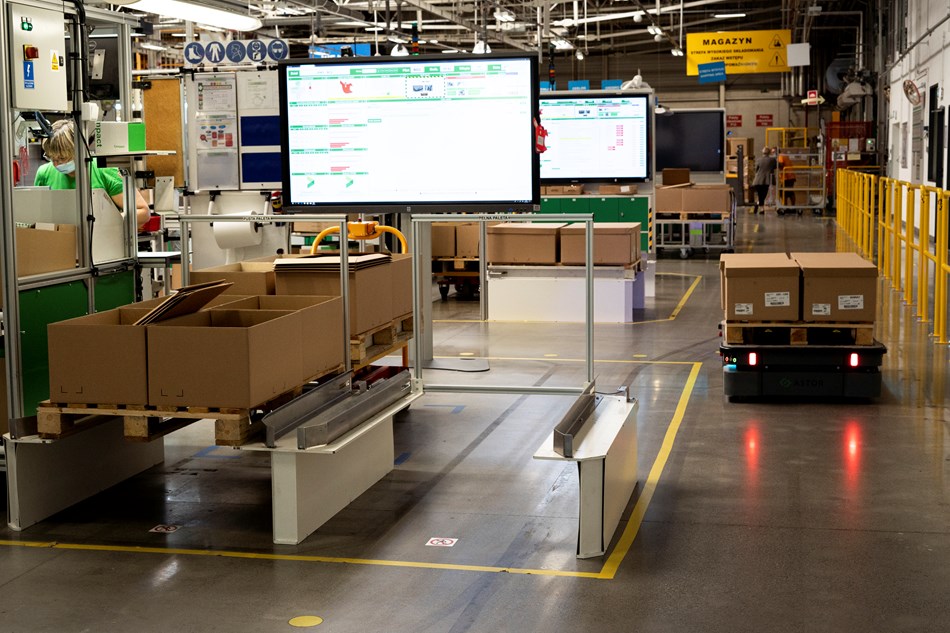Introduction to Autonomous Mobile Robots

Most industries, including manufacturing, shipping, agriculture, and healthcare, have embraced automation to help improve their systems’ efficiency, speed, precision, and safety. As Industry 4.0 continues surging forward, another new resource is becoming more frequently utilized in the efforts to achieve greater levels of optimization: Autonomous Mobile Robots (AMRs).
These machines are not a radically new concept. They are very similar to Autonomous Guided Vehicles (AGVs), which have been used since the 1950s. However, AGVs of the past and present typically maneuver on tracks or a pre-planned route that’s incorporated into the design of the space where they operate. Sometimes, they also require operator oversight.
How AMRs Work
An AMR uses cameras and sensors to navigate through its environment, and does not rely on any human or guided assistance to operate. From a cost perspective, there is an immediate advantage over the previous generation of AGVs because they can work within existing floor plans without installing rails or hiring personnel to operate them.
Additionally, newer AMRs are being equipped with artificial intelligence and machine learning software, so if there are unexpected changes in their environment (e.g. a stray box or tool in the path), they can safely steer around the obstacle and carry on with their task without the need for any human intervention.
Main AMR Uses

The implementation of autonomous mobile robots in a warehouse (or any facility that needs to move material from one location to another) opens up many opportunities. Examples include increased efficiency and growth by improving floor operations, the transportation of goods and resources, and the creation of inventory reports. Compared to early Industry 3.0 automated systems—and especially compared with operations still done manually—AMRs provide a clear advantage within logistics and supply chain operations.
Although it’s still a comparatively new technology, many companies have found numerous advantages of autonomous mobile robots. Some of the most valuable implementations tend to come from areas that focus on completing specific activities rather than entire jobs. Some of the most common AMR uses are:
- Moving inventory within facilities
- Assisting in picking processes
- Pre-sorting components for easier future assembly
Top 5 Benefits of AMRs
Instead of approaching automation with the intent of a comprehensive overhaul, it’s recommended that companies using a manufacturing assembly line first look at where automation can assist current employees and help them perform their work better. Along with that guidance, here are 5 other AMR benefits that can be helpful to consider when adding AMRs to your manufacturing process.
1. Improve Labor Productivity
If you’re exploring how to improve labor productivity in manufacturing, sometimes the best solution for increasing overall operational efficiency is a joint effort between human and robotic labor. For example, let’s say you have a manufacturing assembly line that requires assemblers to regularly or occasionally walk away from their bench to retrieve a necessary part. Similarly, you may have a shipping center that requires workers to frequently walk across the warehouse to select an item and then return to their workstation to complete the task.
In both these scenarios, an AMR could be sent to retrieve the part. By removing this one activity from human workers, you would reduce the time they are away from their workstation to complete low-value tasks. Plus, you would reduce unnecessary energy expenditure, which could translate into more productivity while they are at their stations.
2. Reduce Human Errors
A recent study has shown that “23 percent of all unplanned downtime in manufacturing is the result of human error.” That amount of downtime is more than twice as much when compared to other sectors. Although those downtimes are spread throughout the entire production line, human error is clearly a problem every manufacturing company needs to guard against.
One way to get ahead of potential errors is to be extra attentive when streamlining workflows. As mentioned above, you can use AMRs to maximize the time workers spend on high value tasks. Taking that concept further, you may also find ways AMRs can take over complex steps which, if done poorly by a human, could potentially lead to costly redos or even a system shutdown.
3. Maximize Facility Efficiency
The quicker workers can have what they need, the sooner they can complete their task. It’s helpful to assess the time it takes for workers to finish one or several tasks. For example, if a task requires multiple parts to be assembled or packaged together, this one job may require a worker to spend a lot of time simply gathering those parts.
In this instance, it would make sense to have an AMR fetch those parts. AMRs can travel faster and find items more quickly. As an added bonus, AMRs won’t get bored or fatigued by repetitive tasks, which are common causes of errors. With quicker speeds and fewer errors, you will undoubtedly have higher all-around efficiency.
4. Increase Worker Safety
Collisions and other shop floor accidents have been cited as a challenging business issue for many manufacturers. If not pursued carefully, the effort to increase operational speeds can also lead to an increase in the possibility of accidents.
One of the benefits early adopters of AMRs have identified is the ability to increase speeds while maintaining a high level of safety. The fine-tuned sensors and advanced safety protocols that industrial robot integrators can install on these machines prove that companies can have both speed and safety.
5. Integrate with Ease
The Robotics Business Review reported, “At the end of 2020, mobile robots were deployed in just over 9,000 separate customer sites. By 2025, deployments will increase to over 53,000 sites.” Seeing that thousands have already done it, and thousands more are projected to do it, incorporating AMRs in warehouses and order fulfillment centers is fully accessible to your business.
One of the factors making it easy to integrate AMRs into assembly (line) automation is the fact there are very few structural changes (i.e. expensive) changes that must be made to start using them. Compared to other automated systems that may require a separate vision system inspection, conveyors, end-of-arm tools, and controls, AMRs require much fewer pieces to get started.
How RōBEX Can Help with Automation Integration
AMRs have the potential to be designed and integrated in a number of useful ways. At RōBEX, we welcome the opportunity to build a custom system to meet whatever manufacturing challenges you are facing. We can help implement the finest industrial, collaborative, and autonomous mobile robots with your process and workforce turnkey automation systems and other improvements to your manufacturing line to help with overall operational efficiency. If you are ready to introduce more robust automation technologies into your manufacturing line, we are an automation company you can trust.
From battery assembly to aerospace/automotive assembly automation, we tailor our approach to meet your needs. No matter the size of your business, our experts will work with you to find the most effective system to streamline your process and increase your productivity.
Contact us to Learn more about the RōBEX approach and how we can help.


